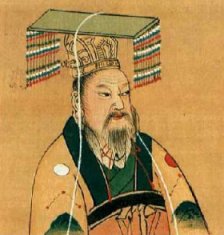This month was my turn to teach. I taught 5th and the 2d graders about the Qin Dynasty of China. I felt intimidated because I knew practically nothing about Asian history. I spent about a week beforehand cramming like a college student before final exams, learning everything I could. This is what I discovered:
 |
| Emperor Qin Shi Huang Source: Wikimedia Commons |
2d grader: They used to have a ruler.
Me: Yes, do you know what the ruler of China was called?
2d grader in the back: PHIL!
Qin (pronounced "chin") was one of several states that fought during the Chinese "warring states period" (ca. 475 BCE-221 BCE). When the fighting was over, Qin had won, taking over the other warring states. This was the beginning of what would eventually become the modern Chinese State. In fact, the western name for the country, "China," probably comes from the name "Qin."
5th grader (musing): Hey . . . Qin . . . Quin-ah . . . China.
The ruler of Qin State, Qin Shi Huang, declared himself the first emperor of China. He had the task of uniting the various Chinese states into one Chinese Empire. He accomplished this by dismantling the smaller walls between the states and replacing them with one Great Wall; by altering the promotion systems in the army and the bureaucracy from one based on noble status to one based on merit; and by uniting the various systems of writing, measurement, and money into one empire-wide system.
Our country is made up of lots of states, too. Why is it that we all see ourselves as Americans instead of citizens of Utah, Wisconsin, South Carolina, etc.?
5th grader: Well, we don't fight wars with people of other states.
Me: Why not, do you think?
5th grade consensus: Because we all work together to do things and we all have the same enemies.
Emperor Qin's reforms made a lot of people happy, but they also made a lot of enemies. The old aristocracy was not pleased that bureaucratic and military promotions were now based on merit. He also angered a lot of people through his book-burning program: Emperor Qin did not approve of the teachings of Confucius. After 3 assassination attempts, Emperor Qin grew paranoid. He hired alchemists to search for the philosopher's stone and create an elixir of life. He did escape assassination, however, eventually dying of old age.
| Several of Emperor Qin's terracotta warriors on display in the Xian Terracotta Warriors Museum. Source: Wikimedia Commons |
Disappointed 5th grader: What, nobody successfully killed him?
Emperor Qin had built himself an elaborate tomb just in case he didn't make it to immortality. He was buried under a man-made hill, inside a necropolis which supposedly contains palaces, towers, rivers of mercury, and replicas of constellations. Chinese archaeologists have found the burial site, but have not excavated due to concerns about preservation of the relics. Tantalizingly, the earth making up the burial site does contain higher levels of mercury than the surrounding earth, suggesting the tomb's description may be based on truth. Archaeologists have dug trenches in the area around the tomb, finding an estimated 8,000 terracotta warriors guarding the entrance. The warriors are life-size and individual--they have different faces and hairstyles, and different uniforms based on the warrior's rank. Originally, they held bronze weapons. Some had terracotta horses, others chariots.
2d grader: That is kind of like the elaborate tombs in Egypt! I know a lot about Egypt and a lot about China because my dad and I watch the history channel.
Links I found helpful:
- The Metropolitan Museum of Art. This website has a timeline of art history which includes a discussion of the Qin Dynasty.
- The Asian Art Museum (San Francisco). The museum's website is targeted toward teachers. Visitors can download information packets containing lesson materials. I used the packets with information about ancient China.
- Asia for Educators (Columbia University). The week after teaching about the history of the time period, volunteers return to the classroom to lead the students in an art project. I used this website as the basis for the 2d week's introduction of Chinese calligraphy in the 5th grade class (it was too complicated for the 2d graders).
- http://www.archchinese.com/. This website, intended for students of Mandarin Chinese at schools and universities in the United States, has animated stroke orders for 7,000 Chinese characters.
Finally, Japanese mahjong. There is an episode of Star Trek: The Original Series in which Kirk teaches a gambling game (Fizzbin) to mobsters in order to distract them. He makes up the rules on the fly, and they are enormously complicated. This game reminds me of Fizzbin. The flash game is the Japanese variant of the four-player game, and I still can't remember all the hands or understand the point system, but I've had a lot of fun trying to figure it out.